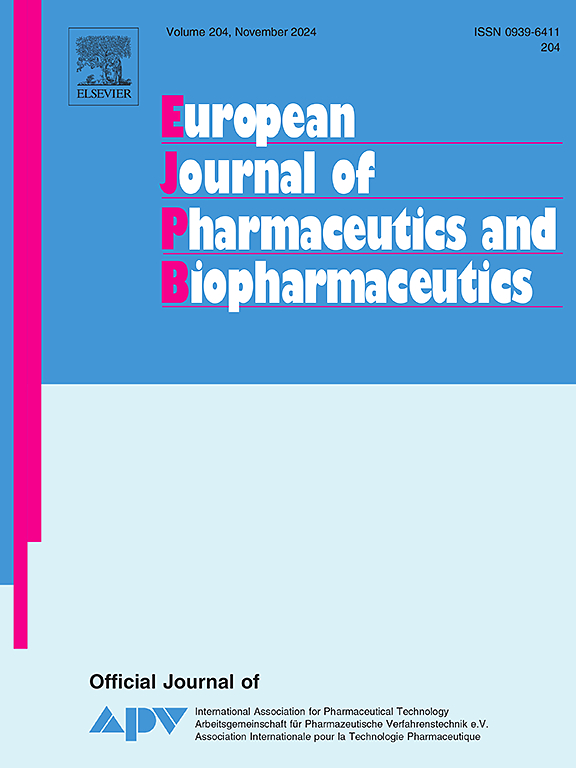Ceftriaxone-loaded albumin-based nanoparticles incorporated into in situ ionic sensitive nasal gels: Development, characterization, and nasal drug deposition studies
IF 4.4
2区 医学
Q1 PHARMACOLOGY & PHARMACY
European Journal of Pharmaceutics and Biopharmaceutics
Pub Date : 2025-05-09
DOI:10.1016/j.ejpb.2025.114743
引用次数: 0
Abstract
Ceftriaxone (CFT) is recommended as the drug of choice for the empirical treatment of bacterial meningitis. However, conventional drug delivery has difficulty in crossing the blood–brain barrier (BBB), leading to insufficient therapeutic efficacy. Therefore, nasal drug administration emerged as a viable strategy, providing the opportunity for brain-targeted delivery to reach effective brain concentrations. In this work, we present the development of in situ nasal gels of CFT-loaded albumin nanoparticles for nose-to-brain delivery. The obtained formulations were characterized in terms of particle size, zeta potential, entrapment efficiency, expansion coefficient, droplet size distribution, in vitro drug release, permeability assay, nasal deposition studies, and antibacterial activities. The BBB-PAMPA permeability assay showed that the in situ nasal gels CFT formulation with 0.2% gellan gum (CFT-GG0.2%) has the highest permeation flux of all. Moreover, nasal deposition studies utilizing a 3D-printed human nasal cavity model revealed that CFT-GG0.2% was able to provide higher CFT concentration in the olfactory area. Interestingly, the developed in situ nasal gels formulation could successfully retain the antibacterial activities of CFT against S. agalactiae, H. influenzae, and N. meningitidis. Altogether, the in situ nasal gels formulation has the potential as a suitable delivery platform for CFT administration through the nose-to-brain delivery pathway.

负载头孢曲松的白蛋白纳米颗粒纳入原位离子敏感鼻腔凝胶:开发、表征和鼻腔药物沉积研究
头孢曲松(CFT)被推荐为细菌性脑膜炎经验性治疗的首选药物。然而,传统的药物递送难以通过血脑屏障,导致治疗效果不足。因此,鼻腔给药成为一种可行的策略,为脑靶向给药提供了达到有效脑浓度的机会。在这项工作中,我们介绍了cft负载白蛋白纳米颗粒的原位鼻腔凝胶的发展,用于鼻子到大脑的递送。通过粒径、zeta电位、包封效率、膨胀系数、滴度分布、体外释药、渗透性试验、鼻沉积试验和抗菌活性等指标对所得制剂进行了表征。BBB-PAMPA渗透性试验表明,含0.2%结冷胶的原位鼻凝胶CFT配方(CFT- gg0.2%)具有最高的渗透通量。此外,利用3d打印人类鼻腔模型进行的鼻沉积研究表明,CFT- gg0.2%能够在嗅觉区域提供更高的CFT浓度。有趣的是,开发的原位鼻凝胶制剂可以成功地保留CFT对无乳链球菌、流感嗜血杆菌和脑膜炎奈瑟菌的抗菌活性。综上所述,原位鼻腔凝胶制剂具有通过鼻到脑给药途径作为CFT给药的合适给药平台的潜力。
本文章由计算机程序翻译,如有差异,请以英文原文为准。
求助全文
约1分钟内获得全文
求助全文
来源期刊
CiteScore
8.80
自引率
4.10%
发文量
211
审稿时长
36 days
期刊介绍:
The European Journal of Pharmaceutics and Biopharmaceutics provides a medium for the publication of novel, innovative and hypothesis-driven research from the areas of Pharmaceutics and Biopharmaceutics.
Topics covered include for example:
Design and development of drug delivery systems for pharmaceuticals and biopharmaceuticals (small molecules, proteins, nucleic acids)
Aspects of manufacturing process design
Biomedical aspects of drug product design
Strategies and formulations for controlled drug transport across biological barriers
Physicochemical aspects of drug product development
Novel excipients for drug product design
Drug delivery and controlled release systems for systemic and local applications
Nanomaterials for therapeutic and diagnostic purposes
Advanced therapy medicinal products
Medical devices supporting a distinct pharmacological effect.

 求助内容:
求助内容: 应助结果提醒方式:
应助结果提醒方式:


